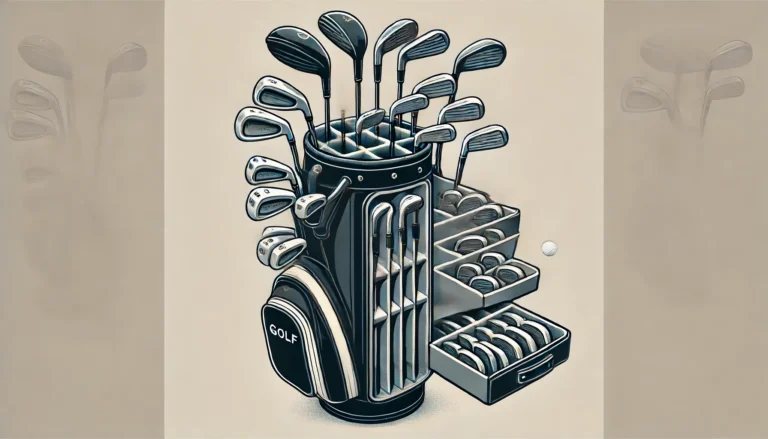How to Reshaft a Golf Club? (Super Easy Guide)
Have you ever picked up your favorite golf club and thought, “Hmm, something feels off”? Well, I’ve been there, and let me tell you, sometimes the solution is as simple as reshafting the club.
But many people don’t know about reshafting. Even if you have heard about it before, chances are you haven’t done it yourself.
It’s super easy.
To reshaft a golf club, start by picking a new shaft. Then, remove the old one, clean the club head, and carefully place the new one. After this, make adjustments if necessary and use a new grip.
If you want to learn reshafting step-by-step, then stick to the end. I am sharing my experience and explaining each step in detail.
How to Reshaft a Golf Club? (Beginner’s Guide)

Reshafting a golf club starts with confirming any issues. If you’re sure the shaft has gone bad, then gather tools and remove the old one. Next, prepare the club head and install the new shaft there.
Simple, right?
Let’s delve further.
Confirm if Your Club Needs to be Reshafted or Not
Note that not every club that feels off needs a new shaft. Sometimes, it’s about identifying the real issue. So, how do you know if your club needs reshafting? Here are a few tell-tale signs:
- Loss of Distance and Accuracy: If you notice your shots are not as sharp or as far as they used to be, it could be a shaft problem.
- Visible Damage: Take a close look at your club. Are there any dents, bends, or splits in the shaft? That’s a clear sign it’s time for a change.
- Change in Swing: Over time, our swing evolves. If your club feels harder to control or you feel uncomfortable during the swing, it means]your current shaft needs to be replaced.
If you want to know more, I am explaining when you should reshaft your clubs later in this article.
Gather Appropriate Equipment Before You Begin
When you figure out that your golf club needs a new shaft, the next step is to gather the right tools and materials. When I first did this, I made sure to have everything on hand to make the process smooth. My golf club reshafting kit consists of:
| Tools/Materials | Purpose |
|---|---|
| New Shaft | Ensures the replacement is the right type for your club. |
| Golf Shaft Puller | To safely remove the old shaft. |
| Epoxy | Secures the new shaft in place. |
| Vise and Shaft Clamp | Holds the club steady during the replacement process. |
| Utility Knife | Removes old grips or excess material. |
| Heat Gun or Torch | Loosens old epoxy on the existing shaft. |
| Grip Solvent and New Grip | Completes the job after shaft replacement. |
You can get the idea that golf club reshafting cost is not much. However, if you hire a professional, then it will cost around 200 to 500 dollars.
Get the Right Shaft (Super Important)
Now, you will pick the right shaft. Keep in mind that it should fit your style and improve your game. Here’s what I suggest:
- Shaft Flex: This is about how much the shaft bends during your swing. There are different flex ratings like Regular, Stiff, Extra Stiff, etc. Picking the right one depends on your swing speed. If you’re not sure, a local golf shop can help you figure it out.
- Shaft Material: There are mainly two types: steel and graphite. Steel shafts are durable and offer more control, while graphite is lighter and can help increase swing speed.
- Length and Weight: Make sure the length of the shaft is right for your height and swing. Remember that the weight also affects your swing. Lighter shafts can increase speed but might offer less control.
When I first picked a new shaft, I spent some time testing different types to see which one felt the best. It’s a good idea to do the same if you can.
Remove the Current Shaft Carefully
Now, let’s talk about removing the old shaft. The process is slightly different for steel and graphite shafts.
For Steel Shafts:
- Secure the Club: Place the club in the vise using the shaft clamp to hold it steady.
- Heat the Hosel: Use the heat gun or torch to apply heat to the hosel (the part of the club head where the shaft fits). This will loosen the adhesive holding the shaft.
- Twist and Pull: Once the adhesive is loose, gently twist and pull the shaft out of the hosel. Be careful, as the club head will be hot.
For Graphite Shafts:
- Protect the Shaft: Graphite is more delicate than steel. So, wrap the shaft near the hosel with a protective cloth to prevent damage when clamping.
- Heat Slowly: Apply heat more slowly and cautiously than with steel. Too much heat can damage the graphite.
- Remove Gently: Use the shaft puller to gently extract the shaft. Avoid twisting too much, as graphite can splinter.
Prepare the Clubhead By Doing 3 Things
Once you’ve removed the old shaft, the next step is to get the clubhead ready for the new one. Here’s what to do:
- Clean the Hosel: First, I suggest cleaning out any old epoxy (the glue used to fix the shaft in place) and debris. I usually use a wire brush for this. Just insert it into the hosel and twist gently to clean the inside.
- Check the Fit: Before adding any glue, check how the new shaft fits into the hosel. It should slide in easily but snugly. If it’s too tight or too loose, you might need to adjust it a bit.
- Prepare the Shaft Tip: If the new shaft isn’t already prepped (which means the tip is slightly roughened), apply a bit of sand.
See More: Can I Use Vaseline on Golf Clubs?
Install the New Shaft Gently
Now, we’re getting to the exciting part – installing the new shaft. In my opinion, that’s the most important step of the whole reshafting process. In this, you will have to do the following:
- Mix the Epoxy: Epoxy is a two-part glue. You’ll mix equal parts of the resin and the hardener.
- Apply Epoxy: Apply some epoxy inside the hosel and on the tip of the new shaft. You don’t need a lot – just enough to cover the surfaces.
- Insert the Shaft: Gently insert the shaft into the hosel. Here, you should make sure the shaft is fully seated. Sometimes, you’ll need to twist it slightly as you push it in.
- Wipe Off Excess Epoxy: If any epoxy oozes out, wipe it off quickly. It’s much easier to clean it now than after it hardens.
- Let it Cure: This is important – let the epoxy cure (harden). In most cases, the time is recommended on the package, which is usually 24 hours.
Adjust if Needed (For Your Comfort)
After installing the new shaft, I have to make slight adjustments almost every time. If you also feel the shaft isn’t sitting properly, then I suggest doing these two things:
- Check the Length: The length of the shaft is crucial. If the new shaft is too long, you’ll need to trim it. I usually measure it against my old shaft to make sure it’s the right length. If you need to shorten it, mark the desired length with tape and cut it carefully using a saw. Remember, it’s better to cut less at first – you can always trim more if needed.
- Align the Shaft: Make sure the shaft is aligned properly with the clubhead (as this affects the club’s performance).
Finish With New Grip (The Last Step)
The final step is putting on a new grip.
- Remove Old Grip: If your club had an old grip, you’d need to remove it. Cut it off carefully with a utility knife and be cautious not to scratch the new shaft.
- Prepare for the New Grip: Clean the area which you will be “gripping.” If there’s any residue from the old grip, wipe it off.
- Apply Grip Tape: Wrap a strip of grip tape around the top end of the shaft where the grip will be. This helps the grip stay in place.
- Apply Grip Solvent: The solvent helps the new grip slide onto the shaft easily. Pour a little inside the new grip and over the grip tape.
- Slide On the New Grip: Align the grip with the shaft and slide it on. It should go on smoothly, thanks to the solvent. Make sure it’s all the way on and aligned correctly.
- Let it Set: Give it a few minutes to set. The solvent will evaporate, leaving the grip firmly in place.
Adding a new grip gives your club a fresh feel. In fact, it can even improve your grip and control during your swing.
That’s everything about how to replace a golf club shaft at home.
When to Reshaft Golf Clubs? The Recommended Times

You should reshaft your gold clubs when you notice any wear and tear or change in the swing. Sometimes, club performance issues also force players to replace the shaft. I suggest getting professional advice as well to ensure whether you need to reshaft your clubs or not.
Changes in Your Swing
Over time, your golf swing might change. This could be due to reasons like improved skills, physical changes, or different coaching techniques. When I noticed my swing had evolved, I realized my old shafts weren’t complimenting my new style.
So, if your clubs feel harder to control or you’re not getting the same results, it might be time to consider a reshaft.
Wear and Tear
Golf clubs can wear and tear over time. This is normal but needs attention. Look for signs like dents, bends, or cracks, particularly in the case of graphite shafts. Similarly, in steel shafts, any sign of rust or corrosion is a clear indicator of reshafting.
You Might Also Like: The Safest Way to Remove Rust From Golf Clubs
Technology Upgrades
Golf equipment technology is continually advancing. Sometimes, your shafts may simply be outdated compared to the latest offerings. Newer shafts can offer better flexibility, weight distribution, and overall performance enhancements. If you’ve been playing with the same shafts for many years, I recommend exploring new technology that might give your game a boost.
Club Performance Issues
If you start noticing a consistent change in your club’s performance, such as decreased distance or accuracy, then change the shaft. Remember that shafts can lose their effectiveness over time. This change is gradual, so you might not notice it immediately. However, paying attention to consistent patterns in your game can help you identify this issue.
Following Professional Advice
Sometimes, the best way to know if it’s time to reshaft is by seeking professional advice. If you’re taking lessons or frequently visit a golf shop, ask for their opinion on your shafts.
People often ask us, “Where can I reshaft my golf clubs?” For this, you can search “Golf club reshafting near me” and go to any nearby place.
The experts can provide insights based on your playing style and the condition of your clubs.
After Significant Breaks or Injuries
If you’ve had a significant break from golf or have recovered from an injury, your swing might change. In this case, I also suggest changing the shaft to match your new swing mechanics.
7 Precautions to Take When Reshafting Golf Clubs

You will need to be really careful when reshafting golf clubs. If you don’t, you will end up damaging your clubs. Let me now walk you through the precautions to ensure safety and effectiveness:
Safety First
- Wear Protective Gear: When using tools like a heat gun, saw, or utility knife during the reshafting, it’s important to protect yourself. I always wear safety glasses and gloves before doing any step. This helps prevent any accidental injuries.
- Well-Ventilated Area: Using a heat gun or torch can produce fumes, especially when heating the epoxy. Make sure you work in a well-ventilated area to avoid inhaling any harmful fumes.
- Be Cautious with Heat: Applying too much heat, especially on graphite shafts, can damage them. It’s crucial to heat the hosel evenly and not to overdo it. I learned this the hard way, so take it from me – gentle and even is the way to go.
Using the Right Tools
- Quality Tools: Ensure all the tools you’re using are in good condition. This includes the shaft puller, vise, clamps, and any cutting tools. Using damaged or poor-quality tools can not only make the job harder but can also be unsafe.
- Proper Use of Tools: Familiarize yourself with how each tool should be used. For instance, when cutting the shaft to length, make sure the cut is straight and clean to avoid any splintering or uneven edges.
Accurate Measurements
Before cutting the new shaft to length or making any adjustments, always measure twice. This reduces the risk of cutting it too short or making any other irreversible errors.
Similarly, when installing the new shaft, proper alignment is crucial for the performance of the club. So, you should pay extra attention to ensure the shaft sits correctly.
Handling Epoxy
When mixing epoxy, I can’t stress enough that getting the right proportions is super important. If not, the shaft won’t sit correctly. Remember to follow the manufacturer’s label/printed instructions precisely.
Also, note that epoxy can be irritating to the skin. If you get some on your hands, wash it off immediately.
Patience is Key
After installing the new shaft, the epoxy needs time to cure. Rushing the reshafting process can result in a weak bond, so I always allow at least 24 hours for it to set properly.
After the epoxy has cured, check your work. Ensure the shaft is securely attached and that there are no gaps or loose areas.
Handling Club Components
Both the club head and the shaft, especially graphite ones, can be damaged if not handled carefully. Avoid clamping them too tightly or applying too much force.
Important Point: When not in use, store the clubhead and shaft in a safe place where they won’t get damaged.
Check out: Read The Best Ways to Carry Golf Clubs on a Motorcycle
Seeking Professional Help
If you’re unsure about any part of the process, don’t hesitate to consult a professional. Sometimes, getting expert advice or assistance can prevent mistakes and ensure the job is done correctly.
Conclusion
As we wrap up, let’s recap the key points about reshafting golf clubs:
- Recognize the signs that your golf clubs need reshafting, such as changes in your swing or visible wear and tear.
- Choose the right tools and equipment, and proceed with caution, especially when handling epoxy and heat sources.
- Precision in measuring and cutting the shaft is vital for optimal performance.
- Don’t compromise on the proper installation and alignment of the new shaft.
- Adjust if necessary to finish the reshafting.
That’s all about how to reshaft a golf club.





